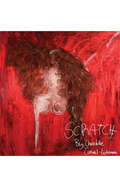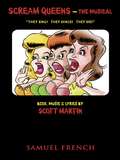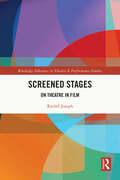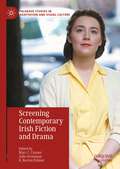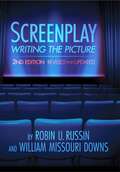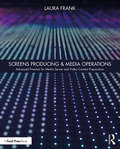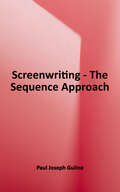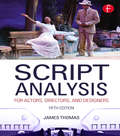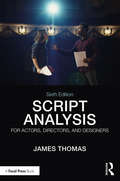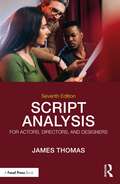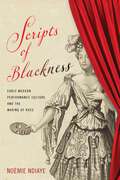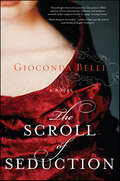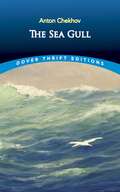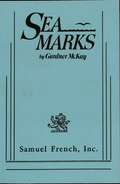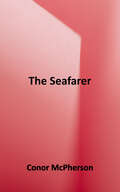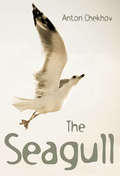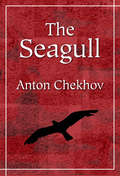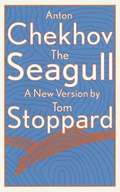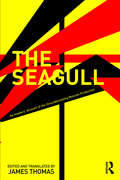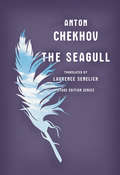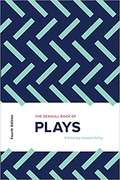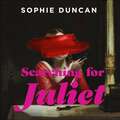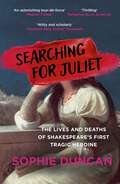- Table View
- List View
Scratch
by Charlotte Corbeil-ColemanWhen fifteen-year-old Anna is told that her mother is dying of cancer, she responds in the only way she knows how—by ignoring the issue. Friends and family are unable to understand her reaction and Anna is increasingly frustrated by their attempts to help her, escalated of course by her persistent itching. Told by Anna with assistance from her best friend, father, aunt, and her dying mother, Scratch is a fresh, funny, and realistic play about the urgency of life and the need to live it to the fullest extent.
Scream Queens - The Musical
by Scott MartinMusical Comedy / 6f (ages 28 - 50+) "They sing -- they dance -- they die!" A hotel ballroom, 1998, and six voluptuous B-movie "Scream Queens" revive their fading acting careers by presenting a musical revue for their fans at a science fiction and horror film convention. From young newbie to seasoned grand dame, the Queens strut their stuff in song and dance to prove "I Got All of the Talent I Need." For 90 minutes of hilarious musical mayhem, they take the audience into the world of no-budget movies with awful scripts, fake monsters and gooey "Special FX." They even involve the audience in a screaming contest and zombie talent search. As each Queen reveals her personal story, we share their hopes and dreams, from Tonya's love of her idol "Fay Wray" to Alexis' advice that "Everybody Starts at the Bottom" to DeeDee's secrets of Scream Queen longevity: "Don't Open That Door." British screen veteran Nadine savors her joy of being "Still In Demand" while Bianca celebrates the lifetime achievements of "Roger Corman" and Richelle laments her own elusive "Happy Endings." They also screen original clips from their direct-to-video "scary movie" spoofs such as "Revenge of the Psycho Bimbos" and "Malibu Vampire Vixens," all hoping to attract the attention of a popular young horror film director lurking in the audience. The Scream Queens will have you convulsed with laughter and begging for the inevitable sequel. "A sassy musical revue; an affectionate funny tribute...with something for everyone." -Los Angeles Times "Campy and full of shtick, affection and great fun!" -The Hollywood Reporter "It's a riot!" -Los Angeles Jewish Times
Screened Stages: On Theatre in Film (ISSN)
by Rachel JosephThis book is devoted to tracing the variety of ways that theatre, theatricality, and performance are embedded in Hollywood cinema as screened stages.A screened stage is the literal or metaphorical appearance of a stage on screen. When the Hollywood style emerged in cinema history it traumatically severed the entwined relationship between film and theatre. The book makes the argument that cinema longs for theatre after that separation. The histories of stage and screen persistently crisscross one another making their separation problematic. The screened stage from the end of the nineteenth century until now offers a miniaturized version of cinema and theatre history. Moments of the stage within the screen compress historical styles and movements into saturated representations on film. Such examples overflow the cinematic screen into singular manifestations of presentness. Screened stages uncover what it means to be simultaneously present and absent.This book would be of great interest to students and scholars of theatre, film, dance, and performance.
Screening Contemporary Irish Fiction and Drama (Palgrave Studies in Adaptation and Visual Culture)
by Marc C. Conner Julie Grossman R. Barton PalmerIn this book, each chapter explores significant Irish texts in their literary, cultural, and historical contexts. With an introduction that establishes the multiple critical contexts for Irish cinema, literature, and their adaptive textual worlds, the volume addresses some of the most popular and important late 20th-Century and 21st Century works that have had an impact on the Irish and global cinema and literary landscape. A remarkable series of acclaimed and profitable domestic productions during the past three decades has accompanied, while chronicling, Ireland’s struggle with self-identity, national consciousness, and cultural expression, such that the story of contemporary Irish cinema is in many ways the story of the young nation’s growth pains and travails. Whereas Irish literature had long stood as the nation’s foremost artistic achievement, it is not too much to say that film now rivals literature as Ireland’s key form of cultural expression. The proliferation of successful screen versionings of Irish fiction and drama shows how intimately the contemporary Irish cinema is tied to the project of both understanding and complicating (even denying) a national identity that has undergone radical change during the past three decades. This present volume is the first to present a collective accounting of that productive synergy, which has seen so much of contemporary Irish literature transferred to the screen.
Screening Early Modern Drama
by Pascale AebischerWhile film adaptations of Shakespeare's plays captured the popular imagination at the turn of the last century, independent filmmakers began to adapt the plays of Shakespeare's contemporaries. The roots of their films in European avant-garde cinema and the plays' politically subversive, sexually transgressive and violent subject matter challenge Shakespeare's cultural dominance and the conventions of mainstream cinema. In Screening Early Modern Drama, Pascale Aebischer shows how director Derek Jarman constructed an alternative, dissident, approach to filming literary heritage in his 'queer' Caravaggio and Edward II, providing models for subsequent filmmakers such as Mike Figgis, Peter Greenaway, Alex Cox and Sarah Harding. Aebischer explains how the advent of digital video has led to an explosion in low-budget screen versions of early modern drama. The only comprehensive analysis of early modern drama on screen to date, this groundbreaking study also includes an extensive annotated filmography listing forty-eight surviving adaptations.
Screenplay: Writing The Picture
by Robin U. Russin William M. DownsScreenplay is a complete screenwriting coursefrom initial idea through final script saleproviding in-depth discussions of theme development; story research; script plotting and structuring; character development; dialogue; writing and rewriting methods; formatting; the ins and outs of marketing and pitching scripts; writing for TV, the Web and video games, and much more. Well-written, comprehensive and filled with both innovative and tried-and-true writing techniques, illustrative screenplay examples and sage advice from veteran writers, Screenplay will help novices as well as working screenwriters improve and sell their scripts. The second edition of this popular manual is completely revised, reflecting current film industry practices, and includes new chapters on such subjects as Webisodes and video games, as well as updates to its many examples.
Screens Producing & Media Operations: Advanced Practice for Media Server and Video Content Preparation
by Laura FrankMedia servers have established themselves as the dominant video playback tool for live events; however, the practice of delivering content to these systems and the structure of the media operations team is still evolving. This book outlines a workflow for video content delivery and describes team communication that can be applied to any entertainment production including: television specials, concert touring, corporate events, theater, as well as special events, film, large audience marketing events, and multi-screen permanent installations. This workflow is hardware and software independent, designed to evolve with future technologies as they become established in the field of multi-screen production, and has been proven professionally by the author and her peers over a decade of productions. The methodology presented will provide insights beneficial to students and current practitioners of media server technology, screens producers, and video content developers. Using real world examples of internationally recognized productions, a foundation is laid for best practices in Media Operations. Additional content, including full-color versions of the images inside the book, is available online.
Screenwriting: The Sequence Approach
by Paul Joseph GulinoThe great challenge in writing a feature-length screenplay is sustaining audience involvement from pages one through 120. This book expounds on an often-overlooked tool that can be key in solving this problem. A screenplay can be understood as being built of sequences of about fifteen pages each, and by focusing on solving the dramatic aspects of each of these sequences in detail, a writer can more easily conquer the challenges posed by the script as a whole. <p><p>The sequence approach has its foundation in early Hollywood cinema (until the 1950s, most screenplays were formatted with sequences explicitly identified), and has been rediscovered and used effectively at such film schools as the University of Southern California, Columbia University and Chapman University. This book exposes a wide audience to the approach for the first time, introducing the concept and then providing a sequence analysis of eleven significant feature films made between 1940 and 2000.
Script Analysis for Actors, Directors, and Designers
by James ThomasScript Analysis for Actors, Directors, and Designers teaches the skills of script analysis using a formalist approach that examines the written part of a play to gauge how the play should be performed and designed. Treatments of both classic and unconventional plays are combined with clear examples, end-of-chapter questions, and stimulating summaries that will allow actors, directors and designers to immediately incorporate the concepts and processes into their theatre production work. Now thoroughly revised, the fifth edition contains a new section on postmodernism and postdramatic methods of script analysis, along with additional material for designers.
Script Analysis for Actors, Directors, and Designers
by James ThomasScript Analysis for Actors, Directors, and Designers, Sixth Edition teaches the skills of script analysis using a formalist approach that examines the written part of a play to evaluate its potentials for performance and production. This new edition offers a more streamlined experience for the reader and features new and revised content, such as a fully updated chapter on postmodern drama, new sections on Associative Thinking and Ambiguous Terms in the Introduction, and revised appendices featuring The Score of a Role and expanded treatments of Functional Analysis for Designers and Further Questions for Script Analysis. Explorations of both classic and unconventional plays are combined with clear examples, end-of-chapter summaries, and stimulating questions that will allow actors, directors, and designers to immediately incorporate the concepts and processes into their theatre production work. An excellent resource for students of Acting, Script Analysis, Directing, and Playwriting courses, this book provides the tools to effectively bring a script to life on stage.
Script Analysis for Actors, Directors, and Designers
by James ThomasScript Analysis for Actors, Directors, and Designers, Seventh Edition, teaches the skills of script analysis using a formalist approach that examines the written part of a play to evaluate its potentials for performance and production. This new edition features new and revised content, including an analysis of two new plays, Kalidasa’s Shakuntala and Federico Garcia Lorca’s The House of Bernarda Alba; information for the theatre designer integrated in chapters throughout the book; and an expanded appendix on critical approaches to script analysis. Explorations of both classic and unconventional plays are combined with clear examples, end-of-chapter summaries, and stimulating questions that will allow actors, directors, and designers to immediately incorporate the concepts and processes into their theatre production work. An excellent resource for students of acting, script analysis, directing, playwriting, and stage design courses, this book provides the tools to effectively bring a script to life on stage.
Scripts of Blackness: Early Modern Performance Culture and the Making of Race (RaceB4Race: Critical Race Studies of the Premodern)
by Noémie NdiayeScripts of Blackness shows how the early modern mass media of theatre and performance culture at-large helped turn blackness into a racial category, that is, into a type of difference justifying emerging social hierarchies and power relations in a new world order driven by colonialism and capitalism.In this book, Noémie Ndiaye explores the techniques of impersonation used by white performers to represent Afro-diasporic people in England, France, and Spain in the sixteenth and seventeenth centuries, using a comparative and transnational framework. She reconstructs three specific performance techniques—black-up (cosmetic blackness), blackspeak (acoustic blackness), and black dances (kinetic blackness)—in order to map out the poetics of those techniques, and track a number of metaphorical strains that early modern playtexts regularly associated with them. Those metaphorical strains, the titular scripts of blackness of this book, operated across national borders and constituted resources, as they provided spectators and participants with new ways of thinking about the Afro-diasporic people who lived or could/would ultimately live in their midst.Those scripts were often gendered and hinged on notions of demonization, exclusion, exploitation, animalization, commodification, sexualization, consensual enslavement, misogynoir, infantilization, and evocative association with other racialized minorities. Scripts of Blackness attempts to grasp the stories that Western Europeans told themselves through performative blackness, and the effects of those fictions on early modern Afro-diasporic subjects.
The Scroll of Seduction: A Novel
by Gioconda BelliManuel is a man of many talents; an art historian and professor, he is also an exquisite storyteller. When he meets 16-year-old Lucía on an outing from her boarding school, he offers to narrate a story of dire consequences—that of the Spanish Queen Juana of Castile and her legendary love for her husband, Philippe the Handsome.Promised to Prince Philippe the Handsome to solidify ties between the Flemish and Spanish crowns, Queen Juana immediately fell in love with her betrothed with all the abandon and passion of her fiery personality. Theirs was one of the most tumultuous love stories of all time. But Juana, who was also one of the most learned princesses of the Renaissance, was forced to pay a high price for being headstrong and daring to be herself. Those at court who could not fathom Juana as heir to the throne of the most important empire of its day conspired against her and began to question her sanity. Eventually she came to be known as Juana the Mad. But was she really insane, or just a victim of her impetuosity and unbridled passion?As the novel unfolds, Lucía and Manuel become enmeshed in a complex psychological web that seduces and incites them to relive Juana and Philippe's story, and eventually leads them to a mysterious manuscript that may hold the key to Juana's alleged madness.
The Sea Gull (Dover Thrift Editions Ser.)
by Anton ChekhovIn this tragic masterpiece portraying the inner anguish of a tormented artist who burns with unrequited love, the Russian playwright uses the death of a sea gull to symbolize the ruined hopes and dreams of his characters. Universally acclaimed as a prototype of 20th-century drama, the play pioneered a new form of impressionistic realism.
Sea Marks
by Gardner MckayDrama / 1m, 1f / Unit Set / Winner of L.A. Drama Critics Circle Best Play Award, this is the touching story of a fisherman living on a remote Irish island who has fallen in love with a woman he's glimpsed only once. Unschooled in letter writing, he tries his utmost to court by mail and after a year and a half succeeds in arranging a rendezvous at which, to his surprise, she persuades him to live with her in Liverpool. Their love affair ends when he is forced to return to a life he understands.
The Seafarer
by Conor McPhersonConor McPherson, who [turned] 35 in August, is one of the genuine treasures of the English-language theatre. It is absolutely intoxicating to ponder what he will give us in the future.”—Irish Echo “The unique and extraordinary aspect of McPherson’s writing is the way in which his characters reveal themselves in tiny details which almost imperceptibly build up an extensive picture of the past, present and future, not just of themselves but of Ireland.”—The Sunday Mail (London) Conor McPherson returns to his native Dublin for the setting of his new play, which he will direct in a much-anticipated production at London’s National Theatre in fall 2006. It is Christmas Eve, and James “Sharky” Harkin, erstwhile fisherman/van driver/chauffeur, gathers with friends at the dingy flat he shares with his blind brother to drink booze and play cards. As Christmas Eve becomes Christmas Day, the familiar-looking stranger Mr. Lockhart reminds Sharky of the bargain he made when they last met in prison—and Sharky suddenly finds himself playing a game with the stakes set at his soul. With this magnificently atmospheric new play, McPherson is once again set to enter his audience, this time with a new take on the Faustian theme. Conor McPherson was born in Dublin, where he still lives. His plays include This Lime Tree Bower, St. Nicholas, The Weir, Port Authority, Dublin Carol, and Shining City, which premiered on Broadway in spring 2006. One of Ireland’s leading playwrights, his work has been produced throughout the United Kingdom and the United States.
The Seagull
by Anton ChekhovAnton Chekhov's The Seagull was written in 1895 and first staged in 1896. It dramatises the romantic and artistic conflicts between four characters: the famous middlebrow story writer Boris Trigorin, the ingenue Nina, the fading actress Irina Arkadina, and her son the symbolist playwright Konstantin Tréplev. Though the character of Trigorin is considered Chekhov's greatest male role like Chekhov's other full-length plays, The Seagull relies upon an ensemble cast of diverse, fully developed characters. In contrast to the melodrama of mainstream 19th-century theatre, lurid actions (such as Konstantin's suicide attempts) are not shown onstage. Characters tend to speak in ways that skirt around issues rather than addressing them directly; in other words, their lines are full of what is known in dramatic practice as subtext. A play more character driven than plot driven, it remains a staple for theatrical production companies to this day.
The Seagull
by Anton ChekhovAnton Chekhov's The Seagull was written in 1895 and first staged in 1896. It dramatises the romantic and artistic conflicts between four characters: the famous middlebrow story writer Boris Trigorin, the ingenue Nina, the fading actress Irina Arkadina, and her son the symbolist playwright Konstantin Tréplev. Though the character of Trigorin is considered Chekhov's greatest male role like Chekhov's other full-length plays, The Seagull relies upon an ensemble cast of diverse, fully developed characters. In contrast to the melodrama of mainstream 19th-century theatre, lurid actions (such as Konstantin's suicide attempts) are not shown onstage. Characters tend to speak in ways that skirt around issues rather than addressing them directly; in other words, their lines are full of what is known in dramatic practice as subtext. A play more character driven than plot driven, it remains a staple for theatrical production companies to this day.
The Seagull
by Anton Chekov Tom StoppardThe Seagull, a spectacular failure on its first appearance, was the play that, on its second, established Anton Chekhov as an important and revolutionary dramatist. Here, amid the weariness of life in the country, the famous actress Arkadina presides over a household riven with desperate love, with dreams of success and dread of failure. It is her son, Konstantin, who one day shoots a seagull; it is the novelist Trigorin who will one day write the story of the seagull so casually killed; but it is Nina, the seagull herself, whose life to come will rewrite the story. This new translation of The Seagull--made by Tom Stoppard for the Peter Hall Company at the Old Vic in 1997--was produced by The Public Theater/New York Shakespeare Festival in New York City in 2001. The volume also contains an Introduction by Stoppard that indicates some of the problems translators have faced since the first English language Seagull in 1909
The Seagull: An Insiders’ Account of the Groundbreaking Moscow Production
by Anatoly Efros James ThomasThis book is an insiders’ account of the groundbreaking Moscow production of Chekhov's The Seagull directed by Anatoly Efros in 1966, which heralded a paradigm shift in the interpretation and staging of Chekhov’s plays. It is a unique glimpse behind the curtain of the laboratory of new Russian theatre in the twentieth century. Efros' articles about Chekhov and The Seagull, his diaries, interviews and conversations, and most importantly the original rehearsal records combine to form an in-depth account of of the director and his working process. This is an essential book for anyone with an interest in Chekhov and the history of modern Russian theatre.
The Seagull
by Laurence Senelick Anton Chekhov"Senelick's accomplishment is astounding."--Library Journal Anton Chekhov is a unique force in modern drama, his works cherished for their brilliant wit and insight into the human condition. In this stunning new translation of one of Chekhov's most popular and beloved plays, Laurence Senelick presents a fresh perspective on the master playwright and his groundbreaking dramas. He brings this timeless trial of art and love to life as memorable characters have clashing desires and lose balance in the shifting eruptions of society and a modernizing Russia. Supplementing the play is an account of Chekhov's life; a note on the translation; an introduction to the work; and variant lines, often removed due to government censorship, which illuminate the context in which they were written. This edition is the perfect guide to enriching our understanding of this great dramatist or to staging a production.
The Seagull Book of Plays
by Joseph KellyThe best-priced alternative to full-length anthologies, this collection offers a compelling blend of classroom favorites and contemporary literary works. Contained in a portable, flexible volume, you’ll find it fits perfectly into a variety of introductory courses.
Searching for Juliet: The Lives and Deaths of Shakespeare's First Tragic Heroine
by Sophie Duncan'A thirteen-year-old girl is at a party. A boy, slightly older, sees her. Juliet. This book is about that girl.'A cultural, historical and literary exploration of the birth, death and legacy of the ultimate romantic heroine - Shakespeare's Juliet Capulet.Juliet Capulet is the heartbeat of the world's most famous love story. She is an enduring romantic icon. And she is a captivating, brilliant, passionate teenage girl who is read and interpreted afresh by each new generation.Searching for Juliet takes us from the Renaissance origin stories behind William Shakespeare's child bride to the boy actor who inspired her creation onstage. From enslaved people in the Caribbean to Italian fascists in Verona, and real-life lovers in Afghanistan. From the Victorian stage to 1960s cinema, Baz Luhrmann and beyond.Sophie Duncan draws on rich cultural and historical sources and new research to explore the legacy and reach of Romeo and Juliet far beyond the literary sphere. With warmth, wit and insight, she shows us why Juliet is for now, for ever, for everyone.(P)2023 Hodder & Stoughton Limited
Searching for Juliet: The Lives and Deaths of Shakespeare's First Tragic Heroine
by Sophie Duncan'Witty and scholarly'JONATHAN BATE, SUNDAY TELEGRAPH'Thrilling'GUARDIAN'Illuminating . . . as vital and provocative as the character herself'LITERARY REVIEW'Buoyant'TIMES LITERARY SUPPLEMENT'An astonishing tour-de-force'MARION TURNER, author of The Wife of Bath: A BiographyWho is Juliet Capulet?Daughter of VeronaLovestruck TeenagerRomantic IconTragic HeroineRebelSearching for Juliet takes us from the Renaissance origin stories behind Shakespeare's child bride to enslaved people in the Caribbean, Italian fascists in Verona, and real-life lovers in Afghanistan. From the Victorian stage to 1960s cinema, Baz Luhrmann, and beyond. Drawing on rich cultural and historical sources and new research, Sophie Duncan shows us why Juliet is for now, for ever, for everyone.
